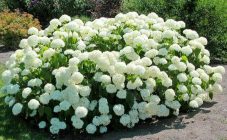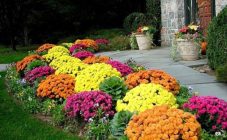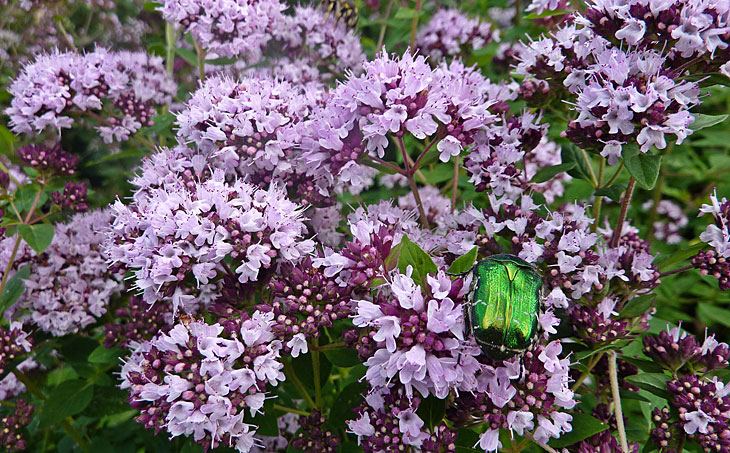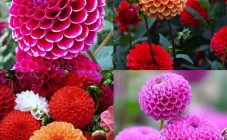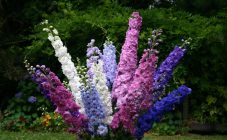Content:
For a very long time, perennial types of ground cover plants, which have beautiful foliage, have gained popularity. With their help, it became possible to replace lawn grass in places that are difficult to mow. One of these unpretentious plants is the creeping tenacious, before growing which it is imperative that you familiarize yourself with the recommendations for planting and proper care in the open field.
The most popular varieties of the culture are Spackler, Black Skallop and Molodilo, the name of which can often be encountered when solving a scanword.
General information about culture
The creeping insect is a perennial herb that belongs to the Yasnotokov family. The natural habitat of the plant is Asia Minor, North Africa, Europe, the Caucasus, the Far East and Eastern Siberia. The tenacious is evergreen, ground cover, its flowers can have a different color, due to which it is actively used in landscape design and gardening.
An interesting fact is that the foliage of the creeping herb is in some cases used for culinary purposes. The aerial parts of the culture are used in many recipes of traditional medicine for the preparation of medicinal products that are beneficial, providing a healing, anti-inflammatory, tonic and hemostatic effect. In the people, the creeping tenacious is usually called the oak tree, one-lip, oak, vologodka, feverish or hearty grass.
Characteristics and description of the variety
The main advantage of the creeping tenacious (in Latin it is called "Ayuga") is its high ability to survive. In the wild, the plant can be found in a forest zone or in a meadow, but only in regions with a warm climate. The main characteristics of the survivor include the following:
- perennial stems creeping, long and having the ability to take root;
- in height, creeping survivors reach from 10 to 50 cm;
- the leaves have a wavy structure and a short petiole (in some varieties it is absent), the foliage is egg-shaped, in most cases;
- inflorescences are spikelets, consisting of 6-8 flowers of light blue or blue.
Every year, the creeping tenacious is gaining more and more popularity due to the fact that its foliage has a different color. Their color saturation is maintained throughout the season, due to which the effect of bright spots on the garden is created. Common varieties of creeping hardy are Multicolor, Sparkler, Black Skellop, Bengal fire and Chocolite Chip.
Planting a creeping tenacious
It is necessary to sow the seeds of the tenacious only in open ground. Planting material must be purchased from specialized garden stores. The plant should be planted with the onset of spring, waiting for the earth to warm up well enough by the sun's rays.But some growers say that it is possible to plant a tenacious plant in the fall, until the onset of the first frost. When planting a plant, the following recommendations must be taken into account:
- the selected areas should be in direct sunlight or in little shade;
- it is good to plant a tenacious plant near the tree trunk circle, because the plant is not able to deprive it of the necessary nutrients;
- well-cultivated garden soil or nutritious, moist loam is suitable for the active growth of Ayuga.
If you wish, then in a specialized garden store you can buy seedlings of the creeping tenacious, which is represented by outlets. They need to be planted in open ground in the second half of May. Weather manifestations in the form of short frosts (from -8 to -10 degrees Celsius) do not pose any danger to the Ayuga. Planting seedlings should be carried out in sunny dry weather.
Between the holes, you need to maintain a distance of 25-30 cm, but as for the growth point, it should be above the ground. It is imperative to tamp the soil around the bushes, after which the planted plants are watered abundantly, trying to prevent exposure of the root system.
Recommendations for proper care
In caring for a creeping tenacious, you do not need to follow any special rules. The plant needs to be watered regularly and also to prevent them from spreading uncontrollably. Before the first young leaves appear on the tenacious, it must be protected from direct sunlight, water it in a timely manner and monitor the optimal level of soil moisture.
After the outlets begin to grow, you need to temporarily stop watering Ayuga and resort to it only in extreme heat or a long dry period. The tenacious creeping grows rapidly, it is for this reason that it is necessary to ensure that it does not spread to the territory that is not intended for it. The perimeter of the bed can be surrounded by a fence of stones, which should be lightly pressed into the ground.
Reproduction of the creeping tenacious
When reproducing Ayuga, they resort to vegetative and seed methods, but you should know that growing a tenacious from seeds is possible only on condition of primary planting. Florists with experience in cultivating Ayuga say that its seeds do not retain the characteristics of the mother plant, therefore, it is recommended to use rosettes for reproduction of the tenacious. It is necessary to propagate the culture in a vegetative way in the first half of spring or early autumn. As for the breeding scheme, it looks like this:
- The overgrown rosettes must be cut off from the plant, after which they must be transplanted into a previously prepared hole (one or several rosettes can be planted in one hole). Even if the outlet has one thin root, it will perfectly take root in a new area;
- If the separation of the outlets is planned no more than 1 time a year, then when they are planted in open ground, a distance of 15 cm should be maintained.If this procedure will be resorted to once every 2 years, then the distance between the plants should be at least 25 cm;
- After the final rooting of the outlets and the active growth phase, it is recommended to temporarily stop watering them.
The tenacious grass can multiply by self-seeding, but this will entail the fact that the young plants that have grown will lack the signs of the mother bush. To prevent unwanted self-seeding, peduncles need to be removed in time, only after they finally stop blooming.When carrying out this procedure, you should make a lot of effort, but as for the basic care of the tenacious, it is very simple.
Diseases and pests
The creeping survivor has a very high immunity, which is able to withstand diseases and pests. But due to long and heavy rains, moisture sometimes stagnates in the soil, attracting slugs that feed on the Ayuga foliage. At the first signs of the presence of parasites, you need to start destroying them until they begin to multiply and destroy the entire garden.
You need to spray the plant with a molluscicide (Met, Frescon, Thunderstorm), which can be bought at any flower shop, ordered online or prepared yourself. It will be effective to use an aqueous solution containing mustard or hot pepper (dilute 100 g of the substance in 5 liters of water, and then process each zhivuchka).
Another way to control pests is to hinder the movement of snails and slugs. To do this, you will need crushed eggshells, which must be scattered between the plants. But you should know that such a method will be effective only if the tenacious is still young, and its layers have not yet covered most of the garden.
Landscape: use in garden decoration, flower beds, lawn
Many flower growers actively use creeping tenacious in landscape design to decorate their garden plots. Using the multi-colored foliage of this plant, you can decorate the foreground of an alpine slide, as well as create rings around the trunks of fruit trees. The creeping tenacious is a harsh "neighbor", so it can not be combined with all cultures. Ayuga can grow well next to coniferous, ampelous and deciduous crops, and it is best to plant it with the following plants:
- irises;
- hosts;
- rudbeckia.
It is strictly forbidden to plant the tenacious next to very weak and small plants. They will be unable to resist the Ayuga, and may even die when the tenaciousness begins to grow.
The creeping insect is a colorful and unusual herbaceous perennial species that has been popular with flower growers for many years. And all thanks to its decorative property. The name of this plant fully and completely justifies itself, since the Ayuga is not afraid of weather conditions, diseases and pests, as well as the absence or abundance of sunlight. With the help of this culture, you can decorate even the most inconspicuous area in the garden or near the house.



